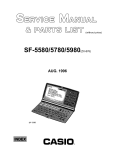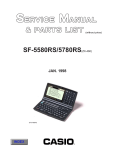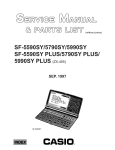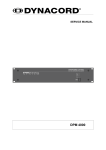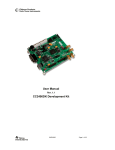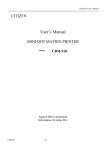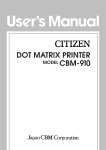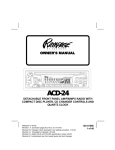Download Casio SF-3500 Specifications
Transcript
(without price) SF-5580E/5780E/5980E (ZX-877) JAN. 1997 R CONTENTS 1. GENERAL GUIDE, RESET ORERATION & BATTERY REPLACEMENT -------- 1 2. SPECIFICATIONS -------------------------------------------------------------------------------- 7 3. DATA COMMUNICATIONS -------------------------------------------------------------------- 9 4. ERROR MESSAGES --------------------------------------------------------------------------- 13 5. OPERATION CHECK -------------------------------------------------------------------------- 14 6. SCHEMATIC DIAGRAMS 6-1. Z876-1 ASS’Y*5 ~ *7 (1/4) -------------------------------------------------------------- 17 Z876-1 ASS’Y*5 ~ *7 (2/4) -------------------------------------------------------------- 18 Z876-1 ASS’Y*5 ~ *7 (3/4) -------------------------------------------------------------- 19 Z876-1 ASS’Y*5 ~ *7 (4/4) -------------------------------------------------------------- 20 6-2. Z876-2 ASS’Y (1/2) ----------------------------------------------------------------------- 21 Z876-2 ASS’Y (2/2) ----------------------------------------------------------------------- 22 7. LSI PIN FUNCTION ----------------------------------------------------------------------------- 23 8. DISASSEMBLY ---------------------------------------------------------------------------------- 24 9. PARTS LIST -------------------------------------------------------------------------------------- 27 10. EXPLODED VIEW ------------------------------------------------------------------------------ 30 1. GENERAL GUIDE, RESET OPERATION & BATTERY REPLACEMENT Mode key Memory keys Display 10-key pad Operator keys Display Change key ON/OFF key Mode keys Cursor keys Light key Scroll/Search keys Function key ESC key Alpha keyboard ■ Display When lighting is dim, you can turn on an EL (electro-luminescent) backlight for easier viewing. To turn on the EL backlight Press the LIGHT key to light up the display for about 15 seconds. Pressing LIGHT while the EL backlight is on turns it off. Display Indicators ~ B N 1 1 2 3 4 5 6 7 8 9 0 A B 2 3 4 5 6 Telephone Directory Mode Memo Mode To Do Mode Reminder Mode Schedule Keeper Mode Calendar Mode Expense Manager Mode Home Time/World Time Mode Calculator Mode Conversion Modes Game Modes Indicates data above —1— 7 C D E F G H I J K L M N 8 9 0 A SHIFT key operation Upper-case input CODE key operation NEW/EDIT screen Index display Data display Snooze feature activated Daily alarm on Key sound on Memory locked Low battery warning Indicates data below ■ All-Reset Use the following procedure to reset the unit to its initial settings. Important! • Do not use a very sharp pencil or other object to press the RESET button. • Be sure to reset the unit before using it for the first time. • Perform the reset operation only after main batteries and back-up battery are correctly installed. • Be sure to press the RESET button after loading main batteries for the first time or if the previous set of batteries went dead. To start the all-reset operation 1. Turn power off. 2. Press the RESET button on the back of the Digital Diary with a thin, pointed object. 3. Now you should press Y for “yes” or N for “no” in accordance with the conditions described below. When to press Y for “yes” • When this is the first time you are using the unit. • When you want to reset the unit and clear all data and settings. • When you are resetting the unit after a data error (page 13). 1. Press Y in response to the message that appears on the display when you start the all-reset operation. 2. Press OK to reset the Digital Diary or ESC to abort. • At this time the message “SET TIME!” appears. • After about two seconds, the Home Time screen appears. 3. Press FUNC, select “Time set”, and then use the procedure on page 18 of Owner’s Manual to set the Home Time. • If you turn power off without setting the Home Time, the “SET TIME!” message appears the next time you turn power on. The Digital Diary will not operate properly until you set the Home Time. When to press N for “no” • After replacing the main batteries. • When you are not resetting the unit to clear all data and settings. • When you are not resetting the unit after a data error (page 13). 1. Press N in response to the message that appears on the display when you start the all-reset operation. • At this time the message “SET TIME!” appears. • After about two seconds, the Home Time screen appears. —2— 2. Press FUNC, select “Time set”, and then use the procedure on page 18 of Owner’s Manual to set the Home Time. • If you turn power off without setting the Home Time, the “SET TIME!” message appears the next time you turn power on. The Digital Diary will not operate properly until you set the Home Time. • Following are the initial settings of the unit after you perform the all-reset operation. Home Time: World Time: Daily Alarm: Sound: Messages: Character input: New York JAN 1, 1996 (MON) 12:00 AM 12-hour format London 12:00 AM Daily alarm — OFF Key — ON English CAPS — OFF ■ Power Supply Your Digital Diary is powered by two AAA-size batteries, and its memory is protected by a single CR2032 lithium battery. Low battery Warning The message, “MAIN BATTERIES WEAK! REPLACE THEM! UNIT WILL NOT TURN ON AGAIN!” appears when battery power is low. Replace the main batteries immediately after this message appears. After replacement of the main batteries, execute RESEToperation. (refer to 4 page) Important! • After the low battery message appears on the display, the unit automatically turns off in about 10 seconds and will not turn back on again until you replace batteries. • Never replace main batteries while the Digital Diary is turned on (while there are figures on the display). • There is not low battery warning for the back-up battery. Be sure to replace the back-up battery once every 5 years. • Be sure you keep a separate copy of all important data that you store in the Digital Diary. Battery Precautions Incorrectly using batteries can cause them to burst or leak, possibly damaging the interior of the Digital Diary. Note the following precautions. • • • • • • • Be sure that the positive (+) side of each battery is facing in the correct directions. Never mix batteries of different types. Never mix old batteries and new ones. Do not expose batteries to direct heat, let them become shorted, or try to take them apart. Never leave dead batteries in the battery compartment. Remove batteries if you do not play to use the unit for a long time. Replace batteries at least once every five years, no matter how much you use the unit during that period. • Never try to recharge the batteries that come with the unit. • Should a battery leak, clean out the battery compartment of the unit immediately, taking care to avoid letting battery fluid come into direct contact with your skin. Keep batteries out of the reach of small children. If swallowed, consult with a physician immediately. —3— To replace the main batteries Important! • Do not remove the main batteries from the Digital Diary while the back-up battery is removed. • Be sure to replace both batteries with two new ones. Do not mix an old battery with a new one. • Be sure to press the RESET button (page 2) after loading main batteries for the first time or if the previous set of batteries went dead. 1. Press OFF to turn power off. 2. Remove the screw that holds the battery compartment cover in place and open the cover. RESET 3. Remove both old batteries and replace them with new ones. • Make sure that the positive (+) and negative (–) ends are facing correctly. 4. Replace the battery compartment cover and secure it with its screw. • Take care that you do not overtighten the screw. 5. Press the RESET button. • This causes the message “ARE YOU USING A NEW UNIT FOR THE FIRST TIME (Y/N)?” to appear. Be sure to press N in response to this message (pressing Y will delete all data in memory). Next, continue with the procedures in the section title “All-Reset” on page 2. To replace the back-up battery Important! • Do not remove the back-up battery from the Digital Diary while the main batteries are removed. • Be sure to replace the back-up battery at least once every 5 years. Otherwise, you run the risk of losing data stored in memory. 1. Press OFF to turn power off. 2. Remove the screw that holds the back-up battery compartment cover in place and open the cover. RESET —4— 3. Insert a thin, pointed object into (A) and remove the old battery. (A) 4. Load a new battery into the compartment, making sure that its positive side is facing up (so you can see it). 5. Replace the battery compartment cover and secure it with its screw. • Take care that you do not overtighten the screw. ■ Turning Power On and Off Press ON/OFF to turn power on and off. Important! • If nothing appears on the display when you turn on power, it means that the main batteries are low. Replace the batteries (page 4) and press the RESET button to resume normal operation. Auto Power Off Function The unit automatically turns power off if you do not press any key for about three minutes. Any alarms you set still sound, even if power is turned off. ■ Function Menus • • • • Pressing FUNC displays a function menu, whose contents differs depending on the mode. Pressing SHIFT FUNC displays a function menu of general system settings (system function menu). Input the number of the left of the function you want to use to select it. To exit from a function menu, press ESC. ■ System Language Your Digital Diary is capable of producing messages in any one of three languages (English, German, Italy). To select the system language 1. Press SHIFT FUNC and then select “Language”. 2. Press the number key that corresponds to the language that you want to use. • To select “ENGLISH”, you would press 1. • The system language automatically changes to English whenever you perform the RESET operation (page 2). Note • In this manual, all display messages are shown in English. ■ Display Contrast Use the following procedure to make the figures on the display darker or lighter. To adjust display contrast 1. Press SHIFT FUNC and then select “Display contrast”. 2. Use O and P to make display images darker or lighter. 3. Press OK to quit. —5— ■ Key Input Sound When the key input sound is turned on, your Digital Diary emits a beep each time you press one of its keys. To turn key input sound on and off 1. Press SHIFT FUNC and then select “Key tone.” Currently selected setting 2. Use O and P to turn the key input sound on and off. • The indicator is on the display while the key input sound is on. 3. Press OK to quit. ■ Destructive Backspace When destructive backspace is turned on, the character at the cursor position is deleted when you press the BS key. To turn destructive backspace on and off 1. Press SHIFT FUNC and then select “Backspace”. 2. Use O and P to turn destructive backspace on and off. 3. Press OK to quit. —6— 2. SPECIFICATIONS Model: SF-5580E/SF-5780E/SF-5980E Main Modes: Telephone Directory, Memo, Schedule Keeper, To Do, Expense Manager, Reminder, Calendar, Home Time, World Time, Calculator, Conversion (metric/currency) and Game (Poker/Blackjack) Data storage: Storage and recall of telephone, memo, schedule, to do, expense, reminder data; calendar display; editing; memory status display Clock: World time; reminder alarm; schedule alarm; daily alarm; accuracy under normal temperatures: ±3 seconds average Calculation: 12-digit arithmetic calculations; arithmetic constants (+, –, ×, ÷); independent memory; percentages; square roots; other mixed calculations General: Display element: 26-column × 8-line LCD Memory capacity: SF-5580E: 128 KB SF-5780E: 256 KB SF-5980E: 512 KB Main component: LSI Power supply: Main: Back-up: Two AAA-size batteries (Type: LR03 (AM4)) One CR2032 lithium battery Battery life: Main: Back-up: Power consumption: In Telephone Mode, approximately 100 hours continuous display; approximately 70 hours with 5 minutes operation and 55 minutes continuous display per hour; approximately 60 hours with 5 minutes operation and 52 minutes continuous display, and 3 minutes backlight operation per hour 5 years if main batteries are replaced as soon as they become weak. 6 months if dead main batteries are left in the unit. 0.25 W Current consumption: Main (Input voltage = 3.0 V): Telephone top menu (Light from EL doesn't shine)3.9 mA (TYP.)/4.8 mA (MAX.) Telephone top menu (Light from EL shines)27 mA (TYP.)/38 mA (MAX.) OFF- 90 µA (TYP.)/120 µA (MAX.) Back-up (Input voltage = 3.0 V): 18 µA (TYP.)/40 µA (MAX.) Auto power off: Approximately 3 minutes after last key operation Operating temperature: 0 °C ~ 40 °C (30 °F ~ 104 °F) Dimensions: Unfolded: Folded: 8.8H × 163W × 169D mm (3/8"H × 67/16"W × 65/8"D) 21.5H × 163W × 91.5D mm (7/8"H × 67/16"W × 35/8"D) Weight: 251 g (8.9 oz) including batteries —7— ■ Memory Capacity Memory capacity differs according to model. Model Memory SF-5580E: 128 Kbyte SF-5780E: 256 Kbyte SF-5980E: 512 Kbyte The following shows the number of items that can be stored in each model. Telephone Directory 8-character name, 10-character Phone 1 number SF-5580E/SF-5780E/SF-5980E: 4,000/9,000/19,000 8-character name, 10-character Phone 1 number, 20-character address SF-5580E/SF-5780E/SF-5980E: 2,000/4,500/9,500 Memo 20-character memo SF-5580E/SF-5780E/SF-5980E: 3,400/7,700/16,000 To Do 20-character description SF-5580E/SF-5780E/SF-5980E: 3,200/7,200/15,200 Schedule Keeper 20-character description, alarm time setting SF-5580E/SF-5780E/SF-5980E: 2,900/6,500/13,500 Reminder 10-character description SF-5580E/SF-5780E/SF-5980E: 5,000/11,250/23,800 Expense Manager 10-character description SF-5580E/SF-5780E/SF-5980E: 3,500/7,900/18,600 —8— 3. DATA COMMUNICATIONS You can transfer data between two CASIO SF-5580E,SF-5780E, or SF-5980E units, or between your Digital Diary and a personal computer only. You cannot exchange data with any other CASIO Digital Diary model. Data communications can be performed while in the Telephone Directory, Memo, Schedule Keeper, Calender, To Do, Reminder, or Expense Manager Mode. ■ Setting Up for Data Communications The following describes what you would do to set up for data communications between two Digital Diary units or between a Digital Diary unit and a personal computer. To connect to another Digital Diary unit 1. Make sure that the power of both units is turned off. 2. Remove the covers from the data communications jacks on the two Digital Diary units. 3. Connect the two units using the SB-62 cable. SB-62 cable Important! • Be sure to replace the connector covers on the Digital Diary units when you are not perfoming data communications. Performing data communications between a Digital Diary unit and a personal computer You must purchase an optional CASIO Data Communication Package in order to perform data communication between your Digital Diary unit and a personal computer. Please note that there are a number of different CASIO Data Communication packages to suit various computers and Digital Diary types. Because of this, you should note the following important points when purchasing a Data Communication Package. If you have any question about which package you need, consult with a expert. • Make sure the Data Communication Package (FA-127) is designed for you with your particular model of personal computer. • For information on how to connect the Digital Diary to a personal computer, see the user’s manual that comes with the Data Communication Package (FA-127). ■ REMARK: FA-127 is the Personal Computer Link (software and cable unit) for Windows. —9— To set up the Digital Diary to receive data 1. While any screen is displayed, press FUNC (or SHIFT FUNC) and then select “Receive data”. • You can perform the above operation in the Telephone Directory, Memo, Schedule Keeper, Calendar, To Do, Reminder, or Expense Manager Mode. 2. Press Y. • This message indicates that the unit is standing by to receive data. • To abort the receive operation, press ESC. • This procedure is the same regardless of whether data is being received from another Digital Diary unit or from a personal computer. ■ Sending Data This section tells you how to operate the Digital Diary to send data to another unit or to a personal computer. About data transfer types… There are a number of ways you can transfer data. All Data Items With this method, you can send all data items stored in the Telephone Directory, Memo, Schedule Keeper, Calendar, To Do, Reminder, or Expense Manager Mode. Mode Data Items With this method, you can send all data items stored in specific modes (Telephone Directory, Memo, Schedule Keeper, Calendar, To Do, Reminder, Expense Manager). In the Schedule Keeper Mode, you can send items that appear on the index display (which you specified using the function menu’s List type item). One Data Item With this method, you can send one data item stored in the Telephone Directory, Memo, Schedule Keeper, To Do, Reminder, or Expense Manager Mode. Notes • For Calendar Mode data, you can send highlight data. • If an alarm (Daily Alarm, Schedule Alarm, or Reminder Alarm) is reached while data is being sent, the alarm does not sound until the data send operation is complete. — 10 — To send one data item 1. Display the data display of the item you want to send. 2. Press FUNC and then select “Send record”. • A message appears asking if you are ready to send. 3. Press Y to start the send operation, or N to abort. • To interrupt the send operation at any time, press ESC. • After the send operation is complete, the display returns to the screen that was on the display before you started the send operation. Then you can repeat the above procedure to send another item. To send all data items in specific modes 1. Press SHIFT FUNC and then select “Send all”. Pointer (selected file) Marker (current setting) 2. Use M and N to move the pointer to the mode whose data items you want to send, and then use O and P to change the setting. • Data in modes set to “Yes” will be sent, while data in modes set to “No” will not. 3. Press OK. • A message appears asking if you are ready to send. 4. Press Y to start the send operation, or N to abort. • To interrupt the send operation at any time, press ESC. • After the send operation is complete, the display returns to the screen that was on the display before you started the send operation. To send Calender data (highlights) 1. In the Calender Mode, press FUNC and then select “Send (Holidays)”. • A message appears asking if you are ready to send. 2. Press Y to start the send operation, or N to abort. • To interrupt the send operation at any time, press ESC. • After the send operation is complete, the display returns to the screen that was on the display before you started the send operation. Then you can repeat the above procedure to send another item. ■ Send All Data Items In a Mode The procedure you should use depends on whether the file whose data items you are sending has multiple files (Telephone Directory, Memo, To DO, Expense Manager) or not (Schedule, Reminder). To send all data items from a multiple file mode (Telephone Directory, Memo, To Do, Expense Manager) 1. Display the initial screen of the mode that contains the data you want to send. • You can display the initial screen for any file. — 11 — 2. Press FUNC and then select “Send all files”. 3. Use M and N to move the pointer to the file whose data you want to send, and then use O and P to change the setting. • Files set to “Yes” will be sent, while those set to “No” will not. 4. Press OK. • At this time the message “READY TO SEND (Y/N)?” appears. 5. Press Y to send or N to abort. • In the Telephone Directory, Memo, and To Do Modes you can also use another method to send all data items. While the index display or data display is on the screen, press FUNC and then select “Send all records”. This causes the message “READY TO SEND (Y/N)?” to appear, so press Y to send or N to abort. To send all data items from a single file mode (Schedule Keeper, Reminder) 1. Display the initial screen of the mode that contains the data you want to send. 2. Press FUNC and then select “Send all records”. • At this time the message “READY TO SEND (Y/N)?” appears. 3. Press Y to send or N to abort. To send listed records in the Schedule Keeper Mode 1. Enter the Schedule Keeper Mode and specify the items you want to send in the index display contents. • See “To specify Schedule Keeper Mode index display contents” on this page. 2. While the Schedule Keeper Mode index display is on the screen, press FUNC and then select “Send listed records”. • At this time the message “READY TO SEND (Y/N)?” appears. 3. Press Y to send or N to abort. ■ To specify Schedule Keeper Mode index display contents 1. Press SCHEDULE to display the initial Schedule Keeper Mode screen, and then press M, N, , or to change to the index display. 2. Press FUNC and then select “List type”. Pointer (selected type) Marker (Current setting) 3. Use M and N to move the pointer next to the schedule type you want to change, and then use O and P to change the setting. • Schedule types set to “Yes” appear in the index display, while those set to “No” do not. 4. Press OK to quit and return to the index display. — 12 — 4. ERROR MESSAGES Data Error Message The data error message appears whenever the Digital Diary’s internal check discovers a problem with data stored in memory. Appearance of the data error message indicates that you must perform the all-reset procedure to correct the problem. Start out with the procedure under “To start the all-reset operation” on page 2, and continue with the procedure under “When to press Y for “Yes” on page 2”. Important! • Even though you are not using the unit for the first time, you must press Y (for “Yes”) when the unit asks “ARE YOU USING A NEW UNIT FOR THE FIRST TIME (Y/N)?” in order to reset the unit after a data error occurs. If you still have trouble after trying the RESET operation, you may have a hardware problem. If so, consult with your nearest CASIO dealer. ■ Message Table Message Meaning Action NOT FOUND! PRESS ESC TO QUIT. Data specified in search operation does not exist in memory. Change specification or cancel search. MEMORY FULL, PRESS ANY KEY. No more room in memory for storage of data. Delete unnecessary data items from memory. ALARM TIME COINCIDENT! Attempt to set an alarm that is already used for another entry. Set a different alarm time or change the existing alarm time. ALARM TIME ALREADY PASSED! Attempt to set an alarm for a time or data that is already passed. Set a different alarm time. DATA COMM. ERROR, PRESS ANY KEY! Error during data communications. Cancel the operation and try again. ARE YOU USING A NEW UNIT FOR THE FIRST TIME (Y/N)? The reset procedure has started. See page 2. CLEAR MEMORY AND SET UP UNIT FOR OPERATION? YES (OK)/NO (ESC) The reset procedure is in progress. See page 2. DATA ERROR! CHECK YOUR OWNER’S MANUAL FOR PROCEDURE! Data corrupted by strong impact, electrostatic charge, etc.. See this page. MAIN BATTERIES WEAK! REPLACE THEM! UNIT WILL NOT TURN ON AGAIN! The main batteries are getting weak. Replace main batteries immediately (page 4). — 13 — 5. OPERATION CHECK REMARKS: 1. Executing this check, the data stored in this Digital Diary disappear. So if you won’t disappear this important data, you should store its data in another Digital Diary (SF-5580E/5780E/ 5980E) referring to the item 3. Data communications in this manual. 2. You can not put out the light from EL while executing this check. ● LCD CHECK 1 Press RESET button on the rear panel while pressing OK button on the front panel. LCD display appears as shown right. (figure-1) figure-1 2 Press OK button four times. LCD display appears as shown right. (figure-2) figure-2 3 Then press OK button. LCD display appears as shown right. (figure-3) 4 Press OK button again. LCD display appears as shown in the figure-1 again. figure-3 ● ROM CHECK 5 Wait 4 ~ 5 seconds, then press OK button. LCD display ROM TEST ROM OK ● RAM CHECK 6 Press OK button. LCD display ROM TEST ROM OK RAM TEST — 14 — 7 Wait about 45 ~ 50 seconds. In the case of SF-5580E, LCD display ROM TEST ROM OK RAM TEST 1 2 8 K OK In the case of SF-5780E, LCD display ROM TEST ROM OK RAM TEST 1 2 8 K OK 2N D RAM TEST 1 2 8 K OK , or LCD display ROM TEST ROM OK RAM TEST 2 5 6 K OK In the case of SF-5980E, LCD display ROM TEST ROM OK RAM TEST 5 1 2 K OK ● KEY CHECK 8 Press OK button. LCD display ROM TEST ROM OK RAM TEST XXX K OK KEY TEST 9 Press any button. For example, press TEL button. LCD display ROM TEST ROM OK RAM TEST XXX K OK KEY TEST TEL After pressing any button, LCD displays a letter or a number correspond to its button. Check all keys (buttons) in this way except to OK button. ● COMMUNICATION CHECK 0 Press OK button. LCD display ROM TEST ROM OK RAM TEST XXX K OK KEY TEST XXX 1 COMM 2 ECHO A Prepare another unit, then execute the procedure described above (1 ~ 10). Another unit’s LCD display ROM TEST ROM OK RAM TEST XXX K OK KEY TEST XXX 1 COMM — 15 — 2 ECHO B Connect two units using the SB-62 cable as shown by the item 3. DATA COMMUNICATIONS (page 9) in this manual. C Press 2 button on any unit (A). This unit’s LCD display ROM TEST ROM OK RAM TEST XXX K OK KEY TEST XXX 2 ECHO D Then press 1 button on another unit (B). Another unit’s LCD display ROM TEST ROM OK RAM TEST XXX K OK KEY TEST XXX 1 COMM 2 ECHO OK In the case of NG, LCD displays a letter “FAIL”. If “OK” was displayed, another unit (B) transmitted data to any unit (A). E Pressing ESC buttons on the both units, return to the condition described in the item 12 . LCD displays on the both units are the same as display shown in the item 11 . F Next, try to transmit data from the unit (A) to the unit (B). G Return to the condition described in the item B using ESC button. H Pressing ON/OFF button twice, turn these units off. — 16 — 6. SCHEMATIC DIAGRAMS 6-1. Z876-1 ASS’Y*5 ~ *7 (1/4) — 17 — 6-1. Z876-1 ASS’Y*5 ~ *7 (2/4) — 18 — 6-1. Z876-1 ASS’Y*5 ~ *7 (3/4) — 19 — 6-1. Z876-1 ASS’Y*5 ~ *7 (4/4) — 20 — 6-2. Z876-2 ASS’Y (1/2) — 21 — 6-2. Z876-2 ASS’Y (2/2) — 22 — 7. LSI PIN FUNCTION CPU (LC868016A): U1 Pin No. Name I/O Function 1 VDD I Power supply for this CPU 2~65 S1~48,C1~16 O Common signals to LCD 66 V1 O 67 V2 O 68 V3 O Bias power supply to LCD 69 V4 O 70 V5 O 71 VLCD O Power supply to LCD 78 VSS — Ground for this CPU 80 P41 O Clock for LCD driver LSI(U2, U3:LC868900) 82 P43 O Signal to LCD driver LSI(U2, U3:LC868900)(AC voltage is supplied to LCD by this signal.) 84 P46 O Read signal to RAM(U42, U62) and LCD driver LSI(U2, U3:LC868900) 85 P47 O Write signal to RAM(U42, U62) and LCD driver LSI(U2, U3:LC868900) 87 P71 I Detection of low battery voltage(=2.5V) from IC(U2:S80725) 90 P10 O Serial data output to another unit or a personal computer 91 P11 I Serial data input from another unit or a personal computer 93 P13 O Control signal to power supply IC(DC/AC inverter IC) for EL (H: EL-OFF/L: EL-ON) 96 P16 O Control signal for buzzer(H: buzzer-ON/L: buzzer-OFF) 98 P57 O Chip select to LCD driver LSI(U3:LC868900) 99 P56 O Chip select to LCD driver LSI(U2:LC868900) 101 P54 O Clock to IC(U8:74HC273) for the keyboard data latch 102 P53 O Control signal to LCD driver LSI(U2, U3:LC868900) 104 P51 O Address bus to RAM(U42, U62) 105 P50 O Address bus to ROM(U5) 106 VDD1 O Power supply for this CPU 107 P30 I 108 P31 I 109 P32 I 110 P33 I Signals for key assign from keyboard 111 P34 I 112 P35 I 113 P36 I 114 P37 I 115 P00 I/O 116 P01 I/O 117 P02 I/O 118 P03 I/O Address bus to the address data latch IC(U7:74HC373) 119 P04 I/O 120 P05 I/O 121 P06 I/O 122 P07 I/O 123 P20 O 124 P21 O 125 P22 O 126 P23 O Address bus to ROM(U5) and RAM(U42, U62) 127 P24 O 128 P25 O 129 P26 O 130 P27 O 131 ADLC O Control signal to the address data latch IC(U7:74HC373) 132 -EROE O Chip select to ROM(U5) 133 -RST I Reset signal for this CPU and LCD driver LSI(U2, U3:LC868900) 134 XT1 I Timer clock for this CPU 135 XT2 O 136 VSS — Ground for this CPU 137 CF1 I Main clock for this CPU 138 CF2 O — 23 — 8. DISASSEMBLY 1 Remove two screws then remove the battery cover. 2 Remove three screws. 3 Open the unit and remove two screws behind the display plate. Display plate — 24 — 4 Remove Lower cabinet (keyboard). Lower cabinet (keyboard) 5 Remove Rubber key and knob. Rubber key 6 Desolder the wire connected to the buzzer on the Lower cabinet (keyboard) from keyboard PCB ass’y. Knob 7 Remove Lower cabinet (display). Lower cabinet (display) — 25 — 8 Remove screws on PCB shown above then remove PCB ass’y. Main PCB (11 screws) Keyboard PCB (13 screws) 9 Separate upper cabinets. REMARK: Heat seal and wires must be placed inside of the hinge in order for the Lower cabinet (keyboard) to fit into place. If heat seal and wires are placed improperly, they are damaged. Heat seal Wires (Black/Red) Hinge Lower cabinet — 26 — 9. PARTS LIST N Item Code No. Parts Name Specification Applicable Q R Z876-1 ASS'Y * There are two type of Z876-1 ASS'Ys in SF-5780E--A type & B type. N U7 U8 U62 * U42, U62 * U62 U42, U62 XT1 XT2 Q30 D2~D17 L3 2114 5771 2114 5770 2012 5520 2012 5520 2012 5519 2012 5519 2590 2691 2590 2690 2259 2712 2390 3005 6420 1950 TTL-IC TTL-IC LSI LSI LSI LSI Oscillator Crystal oscillator Transistor Diode Coil CMO-09-HC373 CMO-09-HC273 CMO-02-128NC-01 CMO-02-128NC-01 CMO-02-256SN-01 CMO-02-256SN-01 RER-01-12 QUA-02-26 TRR-01-M6 DIO-01-LS4148 C01-02-4615 Common Common SF-5580E SF-5780E, A-type SF-5780E, B-type SF-5980E Common Common Common Common Common 1 1 1 2 1 2 1 1 1 16 1 B B B B B B B B C C C The following electronic parts will be not supplied from CASIO. R7 R15~16 R24 R30 R31 C1~2 C3~4 C7~14, C16~21, C31, C34 C15 C30 C32 C33 U2 U3 Q2, Q10 D1 D20 L2 L4 1 2 3 Chip resister(1.5KW) Chip resister(1MW) Chip resister(100KW) Chip resister(220W) Chip resister(10KW) Chip capacitor(33pF) Chip capacitor(18pF) Chip capacitor(0.1mF) RES-01-1.5K RES-01-1M RES-01-100K RES-01-220 RES-01-10K CAP-01-33 CAP-01-18 CAP-01-01 Common Common Common Common Common Common Common Common 1 2 1 1 1 2 2 16 Electrolytic capacitor(10mF) Chip capacitor(15nF) Chip capacitor(68pF) Chip capacitor(1mF) CAP-02-10-25 CAP-01-0015 CAP-01-68 CAP-02-1-50 Common Common Common Common 1 1 1 1 CMO-14-80715 CMO-10-R1501B TRR-01-NPNL6 DIO-01-LS4148 DIO-03-BAT43 COI-02-4630 IND-01-120 JCK-01-1169 BAC-01-988+ BAC-01-988- Common Common Common Common Common Common Common Common Common Common 1 1 2 1 1 1 1 1 1 1 Z876-2 ASS'Y 2114 5768 IC 3065 0708 IC 2259 2713 Transistor 2390 3005 Diode 2390 3004 Schottky diode 6419 6430 Coil 3122 3509 Inductor 3502 2225 Mini jack 6419 6460 Battery plate + 6419 6470 Battery plate - The following electronic parts will be not supplied from CASIO. Chip resister(100KW) R1 Chip resister(1kW) R8 Chip resister(10KW) R9 Chip resister(1MW) R17 Chip resister(100W) R18, R60 Notes: N – New parts Q – Quantity used per unit R – Rank RES-01-100K RES-01-1K RES-01-10K RES-01-1M RES-01-100 R–A: B: C: X: — 27 — Common 1 Common 1 Common 1 Common 1 Common 2 Essential Stock recommended Others No stock recommended C C C C C C C C C C N Item R25 R28 C5 C6~7, C35 C24 C36 N N N N N N 4 4 4 5 6 7 8 9 10 11 12 12 12 13 13 13 14 15 15 15 16 16 16 17 18 18 18 19 20 21 22 23 24 24 24 25 26 26 26 27 27 27 Notes: Code No. Parts Name Specification Chip resister(1.8kW) Chip resister(47KW) Chip capacitor(0.1mF) Electrolytic capacitor(100mF) Chip capacitor(4700pF) Tantalum capacitor(10mF) PCB ASSEMBLY 6420 1880 Z876-1 ass'y 6420 1890 Z876-1 ass'y 6420 1900 Z876-1 ass'y 6419 7320 Z876-2 ass'y 5610 9420 Heat seal 5610 9430 Heat seal 5610 9440 Heat seal 3502 2224 Heat seal 3335 6535 LCD 3312 0057 EL COMPONENTS 6419 6180 Rubber key 6419 6190 Rubber key 6419 6200 Rubber key 6419 6210 Upper cabinet(display) 6419 6220 Upper cabinet(display) 6419 6230 Upper cabinet(display) 6419 6240 Pad 6419 6250 Lower cabinet(keyboard) 6419 6270 Lower cabinet(keyboard) 6419 6290 Lower cabinet(keyboard) 6419 6310 Upper cabinet(keyboard) 6419 6320 Upper cabinet(keyboard) 6419 6330 Upper cabinet(keyboard) 6419 6340 Hinge rubber 6419 6350 Rubber key 6419 6360 Rubber key 6419 6370 Rubber key 6419 6400 Steel nut 6419 6050 Battery spring 6419 6060 Battery spring 6419 6100 Battery spring 6419 6080 Rubber key 6419 6120 Knob 6419 6130 Knob 6419 6140 Knob 3122 3508 Buzzer 3851 2068 Display plate 3851 2069 Display plate 3851 2070 Display plate 6419 5720 Lower cabinet(display) 6419 5730 Lower cabinet(display) 6419 5740 Lower cabinet(display) N – New parts Q – Quantity used per unit R – Rank — 28 — Applicable Q R RES-01-1.8K RES-01-47K CAP-01-01 CAP-02-100-25 CAP-01-4700 CAP-04-10-6.3 Common Common Common Common Common Common 1 1 1 3 1 1 C341328A*5 C341328A*6 C341328A*7 C341329*1 HES-03-ZX876A HES-03-ZX876B HES-01-161055 HES-01-064065 LCD-03-ZX876 LAM-03-ZX876 SF-5580E SF-5780E SF-5980E Common Common Common Common Common Common Common 1 1 1 1 1 1 1 1 1 1 B B B B B B B B B B SF-5580E 1 SF-5780E 1 SF-5980E 1 SF-5580E 1 SF-5780E 1 SF-5980E 1 Common 2 SF-5580E 1 SF-5780E 1 SF-5980E 1 SF-5580E 1 SF-5780E 1 SF-5980E 1 Common 1 SF-5580E 1 SF-5780E 1 SF-5980E 1 Common 2 Common 1 Common 1 Common 1 Common 1 SF-5580E 1 SF-5780E 1 SF-5980E 1 Common 1 SF-5580E 1 SF-5780E 1 SF-5980E 1 SF-5580E 1 SF-5780E 1 SF-5980E 1 Essential Stock recommended Others No stock recommended C C C C C C X C C C C C C X C C C X X X X C C C C X B B B C C C KEY-04-ZX876A-1 KEY-04-ZX876A-2 KEY-04-ZX876A-3 HOU-04-ZX876-00 HOU-04-ZX876-01 HOU-04-ZX876-02 CON-05-507327 HOU-02-ZX876-00 HOU-02-ZX876-02 HOU-02-ZX876-04 HOU-01-ZX876-00 HOU-01-ZX876-01 HOU-01-ZX876-02 HIN-01-ZX-876 KEY-04-ZX876B-1 KEY-04-ZX876B-2 KEY-04-ZX876B-3 NUT-02-M1.7 BAC-01-ZX876BAC-01-ZX876+/BAC-01-ZX876+ KEY-03-U100 LOC-01-ZX876-00 LOC-01-ZX876-01 LOC-01-ZX876-02 BUZ-02-27 LEN-01-ZX877-00 LEN-01-ZX877-01 LEN-01-ZX877-02 HOU-03-ZX876-00 HOU-03-ZX876-01 HOU-03-ZX876-02 R–A: B: C: X: N Item Code No. N N N 28 28 28 29 30 31 32 32 32 33 33 33 6420 1920 6420 1930 6420 1940 6419 5820 6419 5830 6419 5850 6419 5890 6419 5900 6419 5910 6419 5920 6419 5930 6419 5940 Notes: Parts Name Plate Plate Plate Screw Screw Jack cover Battery cover Battery cover Battery cover Battery cover Battery cover Battery cover N – New parts Q – Quantity used per unit R – Rank Specification Applicable INL-01-ZX877-00 INL-01-ZX877-01 INL-01-ZX877-02 SCR-01-1740PMTB SCR-01-1735PBBK JCK-02-ZX876 BAD-02-ZX876-00 BAD-02-ZX876-01 BAD-02-ZX876-02 BAD-01-ZX876-00 BAD-01-ZX876-01 BAD-01-ZX876-02 SF-5580E SF-5780E SF-5980E Common Common Common SF-5580E SF-5780E SF-5980E SF-5580E SF-5780E SF-5980E R–A: B: C: X: — 29 — Q R 1 1 1 1 1 1 1 1 1 1 1 1 Essential Stock recommended Others No stock recommended C C C C C C C C C C C C 10. EXPLODED VIEW 26 16 17 24 13 18 12 14 31 22 21 1 20 8 9 10 5 — 30 — 11 7 25 23 2 4 3 19 6 15 27 19 33 32 29 28 30 MA0200171A

































